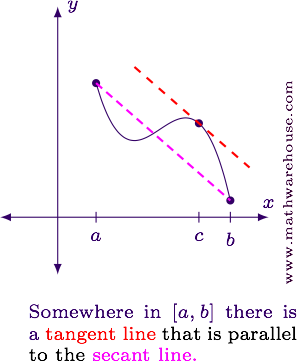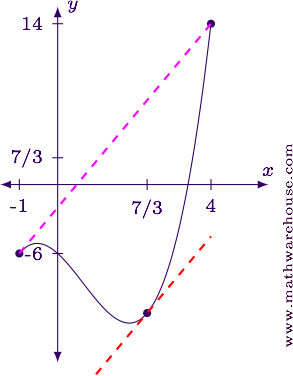Mean Value Theorem for class12
What is Mean Value Theorem?
- The Mean Value Theorem is typically abbreviated MVT.
- The MVT describes a relationship between average rate of change and instantaneous rate of change.
- Geometrically, the MVT describes a relationship between the slope of a secant line and the slope of the tangent line.
- Rolle's Theorem (from the previous lesson) is a special case of the Mean Value Theorem.
- The MVT has two hypotheses (conditions). Specifically,
- continuity on
- and differentiability on .
- If the two hypotheses are satisfied, then
for some .
Basic Idea (Graphical)
Suppose we are looking at a function on an interval . The line connecting the endpoints (the ) will be parallel to at least one of the function's
In order for this to be true, the function has to
Formal Statement of the Mean Value Theorem
Suppose is continuous on and differentiable on . Then there is a point at where
Suppose is continuous on and differentiable on . Then there is a point at where
Understanding the MVT Equation


Examples of Common Questions
Example 1
Suppose over . What value of satisfies the the Mean Value Theorem?
Step 1
Find the slope of the secant line.
Step 2
Find .
Step 3
Determine where is equal to the slope found in step 1.
The MVT guarantees that , and since this is the value we are looking for.
Note, the is excluded since .
Answer
For reference, below is the graph of the function with one of the tangent lines and the secant line.

Shikhakaushal.blogspot.com
for video just go on downside link
for video just go on downside link
